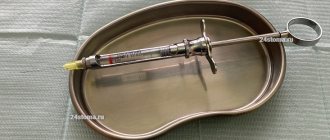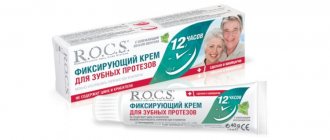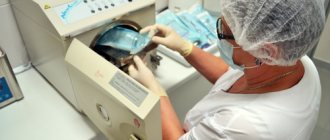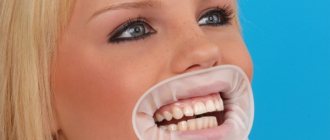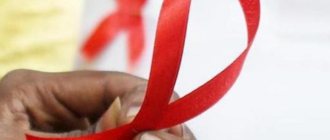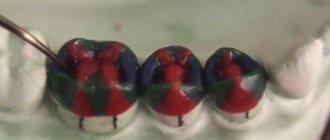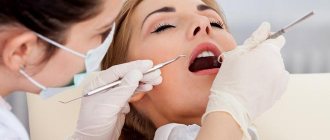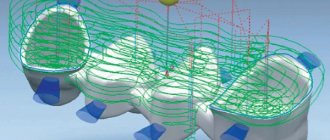Sterility for materials and instruments
Most dental supplies are disposable and supplied in individual sealed packages. These are masks, gloves, napkins, brushes and applicators for applying varnishes and gels, tablets on which pastes are mixed, elements of saliva ejectors, etc.
Reusable instruments and materials undergo special treatment after each patient. It is performed in several stages:
- disinfection - soaking in solution for 2 hours;
- mechanical cleaning;
- washing (ultrasound can be used to remove all contaminants);
- washing in distilled water;
- drying;
- packaging in disposable sealed bags;
- dry heat or steam treatment (at high temperature).
After the sterilizer, the instrument remains in individual packaging, which is opened only before use in the presence of the patient.
Sanitary standards allow the use of conventional autoclaves in dental offices. In such equipment, superheated steam is supplied under pressure to sterilize accessories. The method is effective, but it does not always completely clean the pores on the surface of the instruments (if any). To increase the reliability of processing, dry heat sterilization is used, the temperature at which is so high that all microorganisms die. Another option is the use of automated autoclaves, with control of the operating protocol. To check the quality of cleaning, chemical indicators are additionally used - azopyram samples. If traces of biological material remain on surfaces, they show this. The results of such checks are recorded in a separate journal.
After sterilization and until use, reusable instruments are stored in special boxes with bactericidal irradiators. However, they are not removed from sealed bags.
Stage 2. Pre-sterilization cleaning of rotary dental instruments
Purpose: to remove protein, fat, mechanical contaminants, residues of medications, filling materials from the surface of instruments, to reduce general microbial contamination to facilitate subsequent sterilization.
Pre-sterilization cleaning (PSC) of products is performed manually or mechanized .
In the manual PSO method, instruments are washed in solutions intended for these purposes. To clean the outer surface of products, use brushes or gauze wipes.
To increase the efficiency of pre-sterilization treatment of rotary dental instruments, especially those that are sensitive to mechanical stress, special ultrasonic washers (baths) are used. Under the influence of ultrasound, water vibrates at a supersonic frequency, affecting all areas of the instrument, including hard-to-reach ones, like a “microscopic brush,” destroying the surface layer of contaminants, which facilitates further processing.
After disinfection and PSO, rotary dental instruments are rinsed under running water for the time recommended in the instructions for the use of disinfectants and detergents, then desalted in distilled water, dried and only then sterilized.
The quality of the performed PSO is assessed by performing an azopyram (or amidopyrine) test for the presence of residual amounts of blood, as well as a phenolphthalein test for the presence of residual amounts of alkaline components (in cases of using detergents whose working solutions have a pH of more than 8.5). The control results are recorded in special journals.
Note!
The most convenient to use are disinfectants that allow you to combine the processes of disinfection and pre-sterilization cleaning of rotating products in one stage.
Ultrasonic units can use disinfectants that have cleaning properties. The advantage of many of them is that they are available in the form of ready-to-use solutions and do not require dilution.
Enzyme-based cleansers can be used for PSO. Enzyme-containing preparations destroy the bonds between the cells of the substrate (biological fluid) and break down biological films on the surface of instruments.
An example of calculating the need for disinfectants for processing instruments is presented below.
Treatment of dental offices
Cleaning regulations are determined by sanitary standards. All surfaces must be smooth, easy to clean, without microscopic pores or roughness. They are treated with disinfectants several times a day. Disinfection is carried out for furniture and equipment of walls, floors, ceilings, window sills, etc.
Dental offices must be equipped with special medical furniture. It is made from materials with surfaces that can withstand repeated disinfection and are free of micropores.
After each appointment, additional processing of all items touched by the doctor or patient is performed.
Some infections are transmitted by airborne droplets. To protect against them, dentistry can use bactericidal recirculating lamps (they continuously disinfect the air; they can operate in the presence of the patient), closed-cycle UV emitters, and special filters. A separate ventilation system is installed for surgical rooms. The air passes through fine filters. Access to the room must be through the sterilization department.
Step 3: Sterilization of rotary dental instruments
Goal: completely free instruments from pathogenic and non-pathogenic microorganisms, including their spore forms.
When choosing a sterilization method, you should take into account the recommendations of instrument manufacturers. Most manufacturers do not recommend using modes in which temperatures exceed 160 °C, since this can lead to disruption of the structure of the abrasive layer of rotating products.
Note!
It is not advisable to use air and glasperlene methods to sterilize rotary dental instruments. The optimal method is steam sterilization.
Before sterilization, instruments are packaged in special sterilization disposable materials. Sterilized packaged products are stored in cabinets or on work tables. Shelf life is determined by the type of packaging material, as well as instructions for its use.
Sterilization of unpackaged rotary dental instruments is only permitted with a decentralized processing system in the case of portable sterilizers.
Important!
Products sterilized in unpackaged form must be used immediately for their intended purpose.
It is allowed to store sterile instruments in special bactericidal chambers for the period specified in the equipment operating manual, and in the absence of such chambers - on a sterile table for no more than 6 hours.
Sterile products are placed on the doctor’s dental table in a sterile tray or on a sterile napkin immediately before manipulations on a particular patient.
Sterilization control is carried out at each cycle using special chemical test indicators placed at control points.
Modern chemical test indicators allow you to simultaneously evaluate 2 or more critical sterilization parameters and make a conclusion about the suitability of a sterile batch of products for use.
The results are reflected in the sterilizer operation control logs.
Note!
If there are more than three dental chairs in a dental medical organization, PSO and sterilization of instruments are carried out in specially designated sterilization rooms, divided into “clean” and “dirty” zones.
Dental equipment
Water supply systems. They are used to cool the tooth tissue during preparation. The jet is supplied through the tip. This treatment can only be carried out with distilled water. The design of the units is such that liquid from the oral cavity cannot enter the line even with a constant change in pressure.
Tips. During treatment, they come into contact with tooth tissue and require especially thorough cleaning. It becomes more complicated because the tips may have hidden cavities in which bacteria accumulate. For high-quality cleaning, the tip is blown twice: to remove mechanical impurities and rinse it with a hot antiseptic solution. Only after this is it sterilized in a disposable sealed bag.
Other tools. Endodontic accessories, burs, and scaler tips are stored in closed containers after treatment. You can only remove them from there with disposable sterile tweezers.
Individual dental kits. They include masks, gloves, aprons, and caps for the doctor and assistant. Special bags are used for waste materials. The standard set includes tips for a vacuum cleaner and a saliva ejector. If anesthesia is performed, the carpule and needle are disposable.
The described sterilization and disinfection protocol is used at the DentoSpas clinic and complies with the AntiAIDS and AntiHepatitis program. It ensures the safety of the patient during a dental appointment and eliminates infection and infection.
Cleaning, disinfection, lubrication, sterilization of dental handpieces
1. Preparation Disconnect the turbine handpiece from the adapter and remove the bur from the collet. Move turbines to a designated area with a clean environment. Remove organic contaminants with a paper towel.
2. Cleaning Manual: Clean the outer surface of the turbine with running water (<38˚C, demineralized water is recommended). Automatic: NSK turbine handpieces with this symbol on the body can be cleaned and sterilized in a thermal disinfector. When using the thermal disinfection device, follow the manufacturer's instructions.
NSK recommends using the Care3 Plus for automatic tip cleaning and lubrication. The device is easy to use and provides thorough lubrication regardless of operator skill and experience.
Easy to use:
| Open the door and carefully secure the lugs to the connectors (Up to 3 tips at a time). |
| Close the door tightly. Care3 Plus will not start if the door is not closed securely. |
| Select a cycle (Short, Long or Extra Long) for each tip. |
| Press the START button. Wait about two minutes for Care3 Plus to finish cleaning and lubricating. |
3. Disinfection Manual: Thoroughly wipe the outer surface of the turbine with a cleaning or disinfectant solution.
4. Lubrication It is recommended to lubricate the turbine tips twice a day - at the beginning and at the end of the day. If you continuously use the turbine for more than half an hour, lubrication is strongly recommended. Use an oil absorber to avoid airborne oil dust.
● Mandatory before sterilization ● Mandatory after each thermal disinfection
Manual: Lubricate the turbine with Pana Spray Plus / Pana Spray from NSK. To prevent oil from entering the environment, use an absorbent wipe. Remove excess grease.
Automatic: clean and lubricate turbines with Care3 Plus from NSK. Choose the right adapter for each turbine.
| A) Disconnect the turbine housing from the adapter. B) Insert the Phatelus Connector Spray nozzle into the tip and turn clockwise approximately 10 times. ● To prevent oil leakage, make sure the spray nozzle is securely seated in the tip. ● Use the PA spray nozzle to lubricate Pana Air series turbines. |
| C) Insert the nozzle into the rear of the turbine housing (connector side) and begin spraying. ● Make sure oil is coming out of the front of the head. ● If dirty oil comes out of the head, repeat spraying until clean oil comes out. ● The collet needs to be serviced. The recommended interval is once a week. |
5. Sterilization in an autoclave, class “B”. Now there are many manufacturers of medical autoclaves on the market, but there are only three special models for handpieces - the main one is Melaquick 12 +
If you have a regular autoclave in your clinic (and not a special one for handpieces), place the turbine tips in a sterilization bag and seal it. EN13060 4.6.3 recommends sterilization in an autoclave for 3 minutes (minimum holding time) at 134˚C or 15 minutes (minimum holding time) at 121˚C. NSK recommends Class B or S sterilization. All NSK turbines can be sterilized in an autoclave at temperatures up to 135˚C.
6. Storing handpieces after cleaning and lubrication: Immediately after the sterilization cycle, remove the turbine handpiece from the autoclave. Store the handpiece in a sterile, dust-free container or bring it to the treatment room for use.
